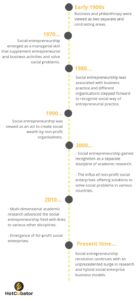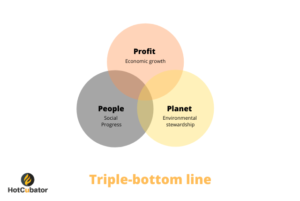
Social entrepreneurship has become a buzzword these days. Being a “social entrepreneur” has become a fad, as we see an increasing number of commercial entrepreneurs claim themselves as ‘social entrepreneur’. On the academic front, a number of the world’s most reputable universities including Harvard (Social Enterprise Initiative at the Harvard Business School), Oxford (Skoll Centre for Social Entrepreneurship at the Said Business School), Stanford (Executive program in Social Entrepreneurship), MIT (MIT Sloan Initiative), have initiated dedicated research centres and academic programs tailored to develop the social entrepreneurship field. The research domain has also seen substantial progress in social entrepreneurship research.
Interestingly, the idea of social entrepreneurship is still characterised with definitional debate and conceptual ambiguity. Due to the apparent complexity of the social entrepreneurship field, there are a variety of social enterprise business models apparent in different parts of the world.
Based on a PhD thesis which was focused to understand the contextual elements of social entrepreneurship, a total of 30 social entrepreneurs were interviewed to understand what they think social entrepreneurship is. The summary of the discussion revealed four different elements which are considered foundational in the understanding of social entrepreneurship. These are:
- Social mission over financial mission
- Innovative solution to social problems
- Self-sustaining business model
- Impact which could be measured.
Social mission over financial mission
Social enterprises operate to earn a financial return but the core driver of such act is a social mission. Every social enterprise starts with the aim to solve a social problem. It solves those social problems through a creative business model which may or may not generate a financial return. The financial return is important for the sustainability of the enterprise but not essential, unlike the for-profit ventures whose primary mission is to generate a financial return and fulfil the needs of its shareholders. The core difference between social enterprises with any other form of enterprise is the priority of mission. Social enterprises prioritise social welfare over any other mission e.g. financial mission, shareholder benefits.
Innovative solution to social problems
Social enterprises bring novel solutions to social problems where public solutions or market-based solutions have failed. Social entrepreneurs start with a social problem and look for ways to bring transformative changes which are also scalable. It should be mentioned here that, the very term innovation does not necessarily mean something entirely ground-breaking or novel. An innovation can be an extension, a duplication, a synthesis or creation of something entirely new. No matter, whichever form of the innovation is adopted by the social entrepreneur or a social enterprise, the essential goal will be to magnify a social problem, find a solution to such problems and finally, be able to scale that to a much broader level which will benefit a large segment in the society. Such innovations are considered as social innovations.
Self-sustaining business model
One of the core characteristics of a social enterprise which separates it from other business models is its capacity to earn revenue coupled with the social mission. A vital dimension intersecting the discussion of social entrepreneurship is a social enterprise’s involvement with financial aspects. Many scholars argue whether a social enterprise should be non-profit or for-profit entity. In fact, the for-profit entity of the social enterprises have been victim of more argument and controversy as a contrasting element to social value creation. Proponents of such arguments posit that social value creation and financial profit maximisation are two completely separate actions and one should not intersect the other. For instance, when Bill Gates (who is one of the richest persons in the world) initiates philanthropic activities through his charitable foundation ‘The Gates Foundation’ such acts are claimed as social entrepreneurial because Bill Gates is also a social entrepreneur. Yet, this causes debate among scholars and practitioners because of his other business activities. Also, when the purely for-profit enterprises make charitable donations or acts of corporate social responsibility (CSR) that also sparks more debate and disagreement.
The other continuum of this debate is the matter of pure non-profits which are run either by donations or tax-payers money and are subject to question as to whether such acts are social entrepreneurial. Therefore, the essential question is how social enterprises should be linked with financial aspects of enterprises. After collecting knowledge from the social entrepreneurs who took part in this study, it was apparent that social enterprise business models capture the essence of both for-profits and nonprofits. Social entrepreneurs, while solving social problems through innovative solutions, can also make a profit as they need to operate the enterprise. But the profit that is gained from such acts is not used for personal gains rather re-invested into further development of the social enterprise. This is a self-sustaining business model which negates the charitable form of social wealth creation, which is less sustainable. Instead, it relies on a long-term mission to eradicate the problem at its source through introducing innovative solutions.
Impact
Another foundational pillar of a social enterprise is its ability to make an impact or in other words – create social impact. The idea of social impact, however, is overarching and there exists many different definitions of social impact. In fact, numerous attempts have been made by academic researchers to find a common ground on how to measure impact and it would appear that there is no widely accepted definition or guideline on social impact. A fundamental difficulty in the measurement of social impact is the underlying contextual factors, which vary across different societies. In general, social impact can be measured based on an enterprise’s action on the well-being of the society which includes the community, environment and the economy. While in most cases the commercial enterprise’s impact is measured by financial impact i.e. a single bottom-line, the social enterprise’s impact is measured on triple bottom line (people, planet and profits). The creation of social impact is inherently linked with the social enterprise’s mission, which prioritises social welfare over financial gain. The main goal of a social enterprise is therefore, to make an impact by achieving social mission which is foundational to its existence.










